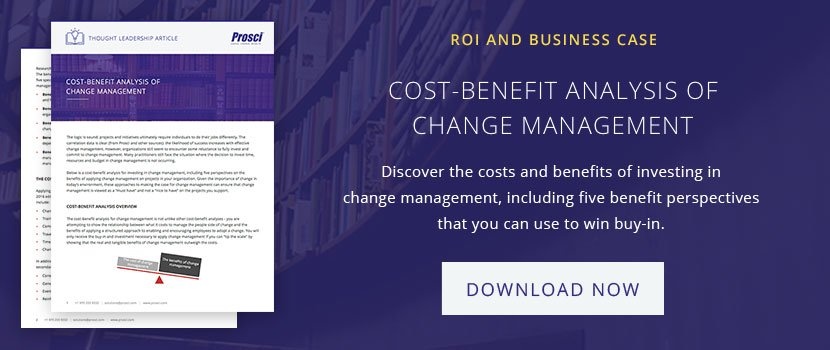The Costs and Risks of Poorly Managed Change

3 Mins
Updated: March 2, 2024
Published: January 19, 2022

When the people side of change is ignored or poorly managed, the project and the organization take on additional costs and risks. When you consider it from this perspective, effective change management is a cost avoidance technique, risk mitigation tactic, and justifiable investment. Here's an overview of common costs and risks, and how to position change management to clearly communicate and share its benefits.
Consequences of Poor Change Management
It's likely that we have all experienced a poorly managed organizational change at some point, either as an offender or victim. We know from experience that when this happens, the individual changes that culminate in organizational change do not take place. We know that when the "people side of change" is mismanaged, projects don't realize the results and outcomes desired. We know that we have a lower likelihood of meeting objectives, finishing on time, and finishing on budget. And we know that speed of adoption will be slower, ultimate utilization will be lower, and proficiency will be lacking—all dragging down expected returns.

Ignoring or mismanaging change manifests as costs and risks that play out on both the project level and organizational level. While some of these costs and risks may seem soft, many are quantifiable and can have a significant impact on financial performance for the project and the organization as a whole.
Project-level costs and risks of mismanaged change
Project-level impacts relate directly to the specific project or initiative forgoing change management. These projects can impact tools, technologies, processes, reporting structures and job roles. They can result from strategic planning, internal stimuli such as performance issues, external stimuli such as regulation or competitive threats, or demands by customers and suppliers. The initiatives may be formalized as projects with project managers, budgets, schedules, etc., or they may be informal in nature but still impact how people do their jobs.
While these projects can take on a number of different forms, the fact remains that ignoring or mismanaging the people side of change has real consequences for project performance:
Costs:
- Project delays
- Missed milestones
- Budget overruns
- Rework required on design
- Loss of work by project team
Risks:
- Resistance
- Project put on hold
- Resources not made available
- Obstacles appear unexpectedly
- Project fails to deliver results
- Project is fully abandoned
When we apply change management effectively, we can prevent or avoid costs and mitigate risks tied to how individual employees adopt and utilize a change.
Organization-level costs and risks of mismanaged change
The organizational level is a step above the project-level impacts. These costs and risks are felt not only by the project team, but by the organization as a whole. Many of these impacts extend well beyond the lifecycle of a given project. When valuable employees leave the organization, the costs are extreme. A legacy of failed change presents a significant and ever-present backdrop that all future changes will encounter.
The organizational costs and risks of poorly managing change include:
Costs:
- Productivity plunges (deep and sustained)
- Loss of valued employees
- Reduced quality of work
Risks:
- Impact on customers
- Impact on suppliers
- Decline in morale
- Legacy of failed change
- Stress, confusion and fatigue
- Change saturation
Applying change management effectively on a particular project or initiative allows you to avoid organizational costs and risks that last well beyond the life of the project.
Costs and risks of failing to deliver results and outcomes
There is one final dimension of costs and risks to consider, beyond the project and organizational impacts. When we try to introduce a change without using effective change management, we are much less likely to implement the change and fully realize the expected results and outcomes. This final dimension provides answers to the question: What if the change is not fully implemented?
If the change does not deliver the results and outcomes—in large part because we ignored the people side of change—there are additional costs and risks.
Costs if the change is not fully implemented:
- Lost investment made in the project
- Lost opportunity to have invested in other projects
Risks if the change is not fully implemented:
- Expenses not reduced
- Efficiencies not gained
- Revenue not increased
- Market share not captured
- Waste not reduced
- Regulations not met
Change Risks and Change Management
Discussing the costs and risks of poorly managed change is yet another way to make the case for change management. Positioning change management as a cost avoidance technique or a risk mitigation tactic can be an effective approach for communicating change management's value or to get support for the resources you need for managing the people side of change.


